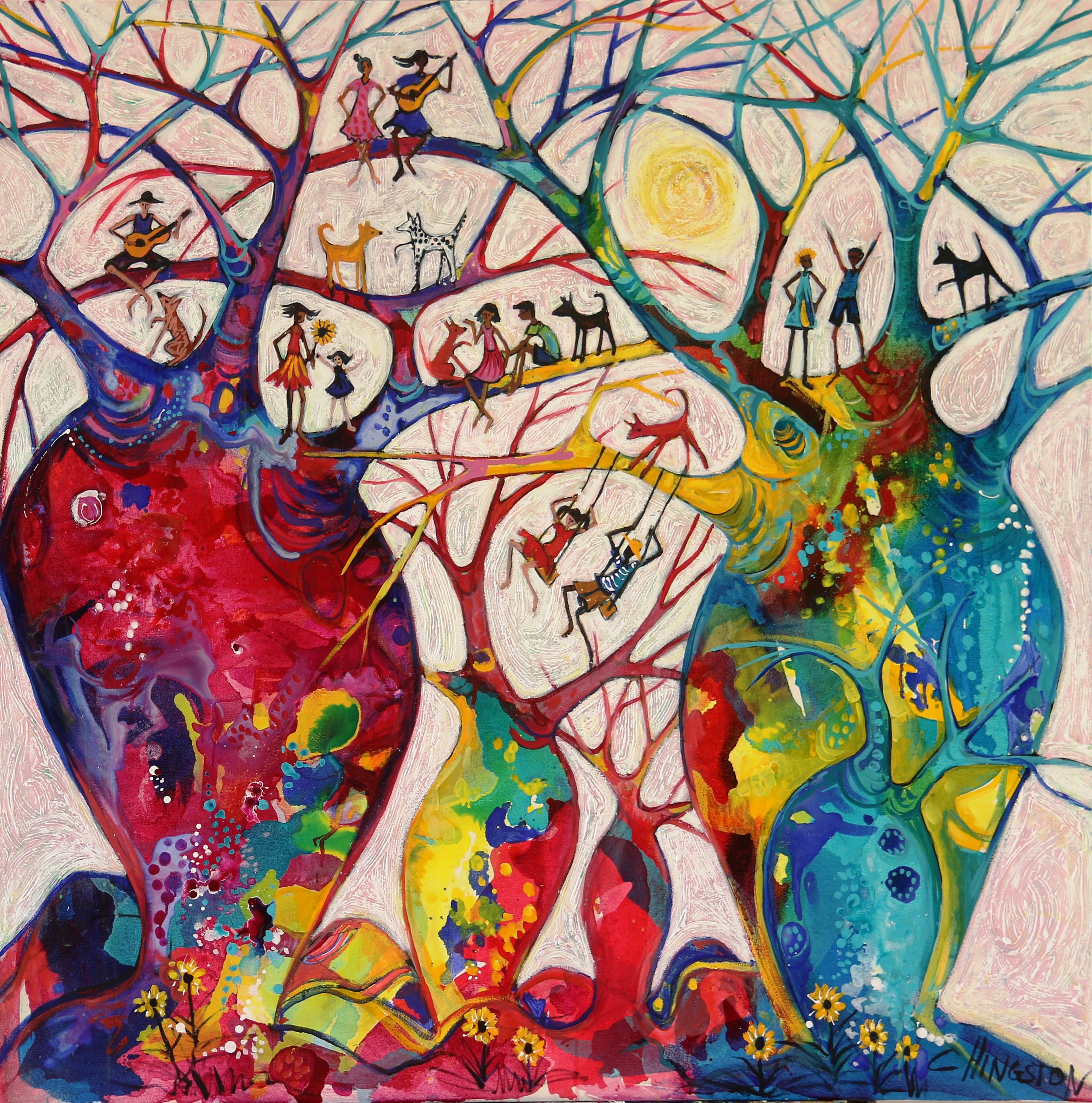Many of Christine Hingston’s works of art, particularly her paintings on canvas, feature the boab tree but what is it about this strange looking tree that makes it so iconic?
Firstly, Australia isn’t known for its deciduous trees which in itself makes it quite unique. Well adapted to seasonal droughts, the boab’s strange shape comes from its ability to store moisture in the fibrous pith of its swollen trunk and branches.
Each year, as days shorten and temperatures drop, leaves fall from the boab trees. The trees shut down for winter, biding their time before embarking on a huge spring growth spurt. Unable to rely on predictable seasonal cycles, our boab trees have become opportunists, waiting out dry spells by tapping groundwater and storing it internally.
Another example of the uniqueness of the Australian boab tree is that it doesn’t have a single native sibling, nor any presence elsewhere in our region.
In 1820, on first encountering a boab, explorer Phillip Parker King was struck by the “gouty habit of the stem, which was soft and spongy and gave it an appearance of disease”.
Living for many hundreds of years, this strange tree seems touched by the bizarre. Its often massively swollen, silvery trunk sprouts writhing and wasted branches that lack foliage for much of the year. These, in turn, bear large, fragrant, creamy flowers that appear at night just before the start of the wet season.
After flowering, boab trees produce fruits that have a brown velvety and brittle shell that encases seeds that are embedded in a mealy pulp.
Artist Christine Hingston with a Boab Tree
Both the pulp and seeds were once important foods for Aboriginal people. The roots of seedlings and the tree’s young leaves are also edible, while adult tree roots can be made into string.
The boab does not rely on a particular soil type and they can be found dotting sandstone hillsides, sandy plains, basalt slopes and the sharp limestone ridges that arc across the southern Kimberley. In the semi-arid western and eastern Kimberley, it stands in isolation or in small, family-like groups – often depicted in the art work of Christine Hingston.
Found from sea level to elevations of about 300m, the boab’s range extends to the Victoria and Fitzmaurice rivers in the Northern Territory, but no further east. With its unique appearance and restricted range, the boab is the botanical symbol of the Kimberley.
The common name ‘boab’ might reasonably be assumed to be of Aboriginal origin, but it’s actually a corruption of ‘baobab’, an Arabic word of African origin that means ‘father of many seeds’.
It’s a clue to the tree’s evolutionary associations because the Australian boab and the African baobabs belong to the same genus. Of the eight baobab species, two are found on the African mainland and the others inhabit the African island of Madagascar.
How did Boab Trees Get to Australia?
It’s one of the great questions in modern day botany – how did the boab arrive in Australia when its only living relatives lie nearly 10,000km away on the other side of the Indian Ocean.
The break-up of the supercontinent saw Australia, Africa and Madagascar detach from each other more than 120 million years ago (mya).
Genetic analysis of the species on both sides of the Indian Ocean shows they’re still too closely related for the boab to have been isolated for as long as that.
What scientists disagree on is the manner and timing of the arrival of the boab’s ancestors on Australia’s shores.
There’s still much to learn about the evolutionary relationships among the baobabs and boab, but research suggests that the genus Adansonia, to which all these trees belong, split sometime between 2 and 15 million years ago.
By then, continental drift had carried Australia close to its current geographical location, which came with an extensive tropical zone suitable for baobabs.
It is suspected that the boab and its African relatives evolved from a now-extinct common ancestor that grew somewhere in Asia, perhaps in areas long ago inundated by rising seas.
Wherever they once grew, the trees’ pulpy flesh would be unlikely to yield fossils. But, there is hope among botanists that fossilised seeds, seedpods or even pollen might one day be found and provide a clue to the boab’s ancestry.
If the common Asian ancestor theory is not correct, another possibility would be that the baobab’s seeds floated to Australia. Oceanic drift is a common means of plant dispersal and African baobab seedpods have travelled as far as the Indian Ocean island of Aldabra, and can remain viable after being immersed in sea water for as long as six months.
The final theory is that humans introduced the boab to Australia and that people moving out of Africa carried the tree’s seeds as a valuable food source.
Boab Ceramics by Christine Hingston
Boab Tree Art Work
It is not only the esteemed artist, Christine Hingston who is known for painting boab trees. What appear to be boab trees are occasionally found in Kimberley’s exquisite, ancient rock paintings. Many of the boab rock paintings seem to tell a story of the importance of the boab for survival. There are also similarities between the Kimberley art works and those found in East Africa which likewise depict the baobab tree.
Are you interested in Boab tree art or investment art? Take a look at Christine Hingston’s paintings on canvas here or email Christine if you are interested in having a piece commissioned.



